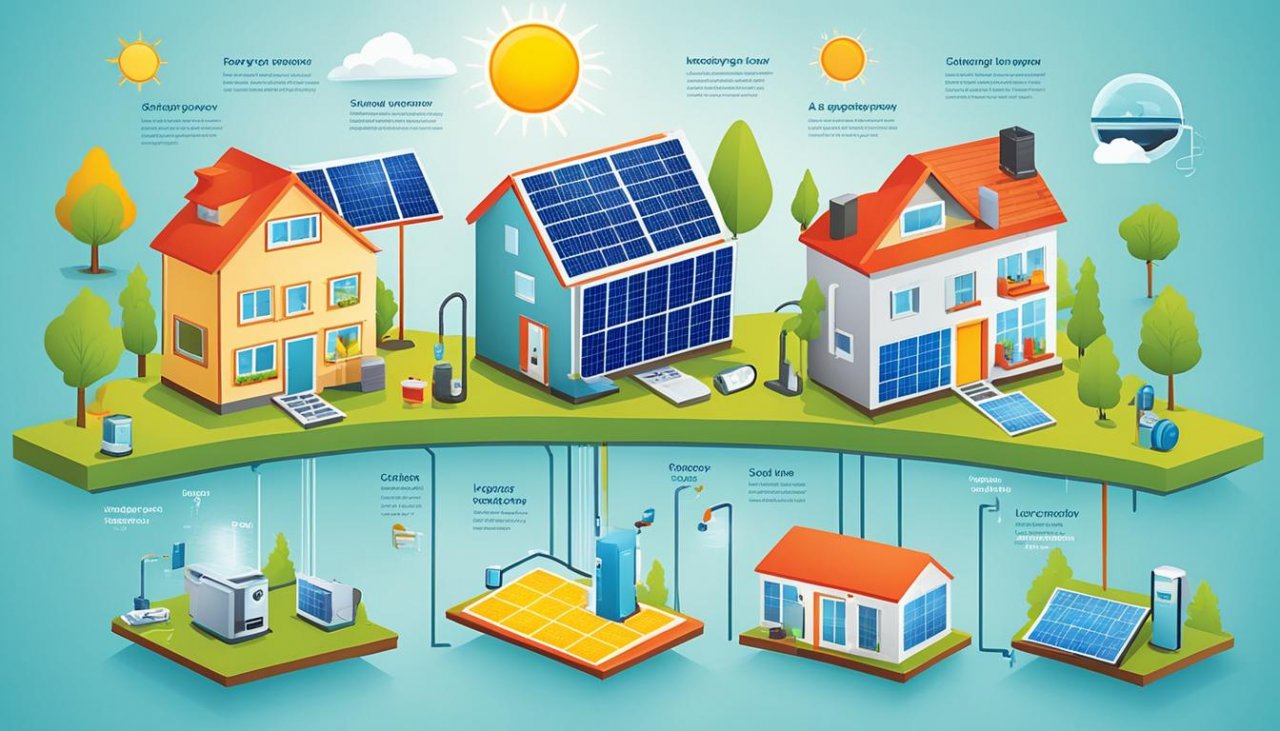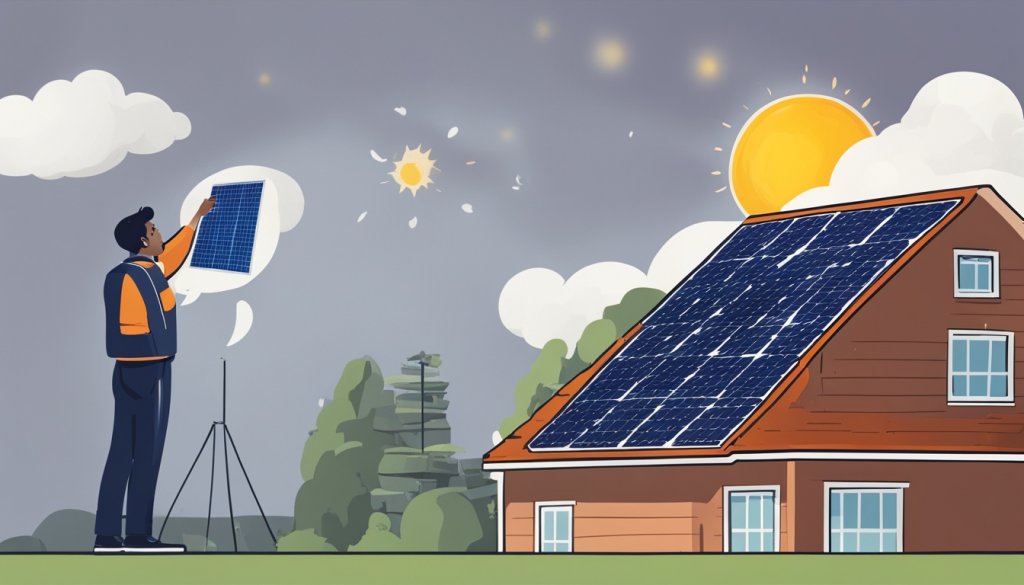Have you ever thought about why only a tiny part of homeowners in the U.S. use solar energy? As solar power grows, it’s key to teach people more about it. By learning about solar energy, homeowners can make smart choices that improve their lives and help the planet.
Using solar energy can save a lot on electricity bills and even increase a home’s value. The U.S. Department of Energy offers many resources to help us learn about solar technology. A recent survey by SunPower found that many people don’t have the right info, which stops them from going solar. Let’s look into these benefits and help ourselves and others learn about renewable energy.

Key Takeaways
- Less than 5% of homeowners in the U.S. have adopted solar energy.
- Solar energy can significantly reduce electricity bills over time.
- Educational programs are necessary for building a skilled workforce in the solar industry.
- Workshops and webinars play a vital role in engaging communities with solar energy education.
- Over 75% of U.S. consumers desire more reliable information about solar options.
- Businesses adopting solar energy experience lower operating costs.
- A solar PV installation occurs every 4 minutes in the U.S.
Introduction to Solar Energy
Exploring renewable energy, I find solar energy really interesting. It uses the sun’s rays to make clean, sustainable power. This is great because it doesn’t harm the environment like fossil fuels do. Over time, solar power has become easier for more people to use.
Did you know solar technology has grown a lot since 1839? Now, photovoltaic cells are used all over the world. They power everything from homes to the International Space Station. Learning about solar power helps people make smart choices about using it.
Solar energy has many uses. Concentrated Solar Power (CSP) uses mirrors and lenses to focus sunlight. This creates heat that can make electricity. For example, CSP plants in California make lots of energy, showing how solar can help in many areas, like homes and hospitals.
As we need more renewable energy, learning about solar power is key. It helps us see how it can save money and protect the planet. The more we learn, the better we can choose to live sustainably.
Understanding Solar Energy Basics
Solar energy is about using sunlight to make electricity. It’s a clean energy source that helps us use less fossil fuels. This is key in fighting climate change.
What is Solar Energy?
Solar energy comes from the sun’s rays. We use technologies like photovoltaic (PV) cells in solar panels to get this energy. These cells turn sunlight into electricity, which is better for the planet and can save money over time.
How Solar Energy Works
Solar energy uses photovoltaic technology. When sunlight hits PV cells, it makes electrons move, creating electricity. This method is reliable, with most solar panels lasting 25 years or more.
Installing solar PV systems costs between $6 to $10 per watt. People can pay for them using home equity loans or improvements. Thanks to a 30% tax credit, getting solar technology is easier. Using solar energy can lead to $0 electricity bills, making it a smart choice for going green.
Importance of Solar Energy Customer Education
Teaching people about solar energy is key to moving to renewable energy. It helps them understand the costs, benefits, and incentives of solar technology. Educational efforts from utilities make solar energy clearer and more reachable for homes and businesses.
More K-12 schools are turning to solar power, showing how effective education is. Since 2017, Virginia has seen a jump from 29 to 86 schools using solar. This change is thanks to efforts to inform school leaders about solar’s cost-saving potential.
With solar, schools could cover up to 75% of their energy needs. K-12 schools spend over $6 billion on energy each year. Switching to solar could save a lot of money, which could go to books and tech.
Projects that let students work on solar installations boost their interest in STEM fields. These projects teach them about sustainable energy and encourage them to care for the environment. Schools using solar energy help fight climate change and improve education, showing why teaching about solar is so important.
Benefits of Solar Energy for Homeowners
Thinking about solar energy can bring big perks for homeowners. It’s not just about saving money on bills. Solar energy can also make your home more valuable and help the planet.
Cost Savings on Utility Bills
One big plus of solar energy is cutting down your utility bills. Solar panels can make your monthly bills much smaller or even zero. A 7.15-kilowatt system can power an average home in places like Austin, Texas.
These panels turn 15% to 20% of sunlight into electricity. This means big savings, especially when energy costs are highest.
Increased Home Value
Adding solar energy can also increase your home’s value. Studies show homes with solar panels sell for more money. Buyers like these homes because they offer energy independence and lower bills.
This means solar energy is a smart choice for homeowners. It saves money and can make your home worth more when you sell it.
Environmental Impact Reduction
Using solar energy helps reduce your carbon footprint. It makes your home eco-friendly. By choosing clean energy, you’re fighting climate change.
More people using solar energy also helps the economy. It creates jobs and supports a green economy.

Solar Energy Resources for Customers
Learning about solar energy can seem tough, but there are many resources to help. The U.S. Department of Energy has tools for consumers, from picking systems to installing them. They keep their info up-to-date so I can make smart choices about solar power.
U.S. Department of Energy Resources
The U.S. Department of Energy has guides and tools to teach me about solar energy. They offer the Residential Consumer Guide to Solar Power, which helps me pick the right system. Knowing about these resources makes me better informed, leading to a greener energy future.
Local Utility Company Programs
Local utility companies have programs for solar customers. These programs include rebates, incentives, and workshops to learn more. Knowing about these can help me get the most out of solar energy and make better choices.
Online Tools and Calculators
The internet has many online tools and calculators for solar energy. These can estimate my savings and help me understand my energy use. Using these tools gives me a clear view of how solar energy can benefit my home, making the switch easier and more rewarding.
Solar Energy Customer Education Initiatives
Learning about solar energy is more than just knowing the basics. It’s about reaching out to people and inspiring them to use renewable energy. I’m excited to talk about some top solar energy education programs for students and homeowners. These programs are key in making people understand solar technology better and getting the community involved.
Workshops and Seminars
Community workshops by schools have really made a difference. After these hands-on sessions, there was a 25% jump in solar panel installations in local areas. Solar companies run workshops on photovoltaic technology and how renewable energy helps the planet. I’ve seen how these programs make students more interested in renewable energy, with 85% showing more interest after joining in.
Industry conferences also offer great chances to meet solar experts. These events give more insights and help people learn about solar technology.
Online Educational Platforms
Online learning is also a big part of teaching people about solar energy. Now, many colleges offer programs in renewable energy, reaching more people. These online tools make learning about solar easy and clear. They explain how to install solar panels and the benefits of getting financial help for it.
This kind of learning makes people more likely to use solar energy at home. It helps us move towards a greener future.
Understanding Solar Energy Incentives
Exploring solar energy incentives is key when thinking about solar power. These incentives make going solar easier and cheaper for homeowners. They include federal tax credits and state programs that boost the benefits of solar energy.
Federal Solar Tax Credits
The federal solar tax credit lets me deduct up to 26% of my solar panel system’s cost from my taxes. This rate will drop over time, but it’s still a big help. It makes solar power more affordable, helping more people switch to renewable energy.
State-Specific Incentives
In Massachusetts, there’s a 15% income tax credit, up to $1,000, for solar system costs. This goes along with the federal tax credit, cutting down costs even more. Plus, solar installations here are tax-free, giving more savings. Community solar programs offer savings of 10-20% a year through shared projects.
These incentives boost solar energy use, help local companies, and create jobs. Knowing about them shows the big financial and environmental benefits of solar energy.
Common Misconceptions About Solar Energy
Exploring solar energy, I want to clear up some common myths that might stop people from using it. Many think solar panels don’t work well in cloudy or rainy places. But, new solar tech can catch sunlight even when it’s not fully sunny. This shows that solar energy is good for many places.
Some worry about the cost of solar systems. Yes, starting can cost $15,000 to $35,000. But, there are ways to make it cheaper, like rebates and tax credits. These options help make solar energy more affordable.
Some also think solar panels can damage roofs. But, if experts install them, they usually don’t. They make sure the roof stays safe. Plus, solar panels can even help farms, showing they don’t take up too much land.
Schools and communities are now using solar energy well. For example, Baugo Community Schools have a big solar carport. It gives energy and shade for cars, showing solar’s many uses.

I hope sharing the truth about solar energy helps people feel ready to try it. Knowing the facts can lead to a greener future. I encourage everyone to learn more about solar energy.
Solar Energy Guide for Beginners
Starting with solar energy is exciting. I’m new to it, and I want to share some key steps for beginners. This guide will help you pick the right system, install it, and keep it working well.
Steps to Choosing a Solar System
I begin by looking at my energy use. It’s important to know how much electricity I need. I look into different solar technologies like monocrystalline and polycrystalline panels to make a good choice.
I also think about how much sun my area gets. This helps me pick panels that will work best. Planning carefully is key to getting the most from solar energy.
Installation Process Explained
Once I’ve picked a system, it’s time to install it. I hire a certified pro for safety and to follow local rules. The way panels are tilted and facing is important for catching the most sun.
The installation must pass checks to work well and meet standards. Knowing about installation is crucial for beginners in solar energy.
Maintenance and Upkeep Tips
Keeping my solar system running right is as important as installing it. Regular checks spot problems early. Cleaning panels after rain or storms helps them work better.
Knowing about state incentives for upkeep can save money over time. Following these tips keeps my panels efficient for 25 to 30 years.
Importance of Sustainable Energy Education
Learning about sustainable energy is key to a cleaner environment. It teaches people to move from old energy sources to new ones. This change helps our planet stay healthy.
From 2010 to 2020, the use of solar power grew a lot. It went from 40,334 MW to 709,674 MW worldwide. This shows how important it is to make smart choices. When people know about sustainable energy, they choose it more often.
The use of solar power increased by 100 times from 2005 to 2018. This shows that education leads to more demand for green energy. Costs for electricity from solar power dropped by 77% from 2010 to 2018. This makes renewable energy more affordable.
I envision a future where sustainable transport, buildings, and communities are common. California aims to use only renewable energy by 2045, setting a high goal. Education on sustainable energy is crucial for achieving such big changes.
Solar Energy Customer Education Strategies
Teaching customers about solar energy is key to spreading the word and building understanding. Using different ways to reach out can really help talk to both new and current customers. Social media is a great way for companies to share cool solar energy stuff. This makes info easy to get and helps more people learn.
Utilizing Social Media for Outreach
Groups like Hawaiian Electric use social media, like Pinterest, to teach people about saving energy. They share easy-to-understand posts that make saving energy simple. Being active on social media lets them get quick feedback and start talks with the community about solar energy.
Creating Engaging Content
Good solar energy content is more than just numbers; it’s about stories. Companies like PG&E have taught over 82,000 students with their materials. Talking clearly about solar energy’s perks and costs is crucial. Adding fun parts and real stories makes learning about solar energy better, supports green habits, and keeps customers happy.
Conclusion
As we conclude our talk on solar energy customer education, it’s clear how crucial it is for people to grasp the many benefits of solar energy. The shift towards renewable energy sources like solar power excites me. By focusing on education, we can boost public knowledge and support for making smart choices.
Solar energy offers many perks, like lower utility bills and chances to help the environment. It also opens doors for learning new things. Solar power can save communities a lot of money through incentives, partnerships, or eco-friendly actions. Every step we take in learning about solar energy helps us and our communities.
Our drive to use more solar energy depends on sharing what we know. By making people understand solar energy’s effects on our wallets and planet, we encourage others to join us. This way, we can use solar energy to the fullest, creating a brighter, greener future for all.
See how FieldAx can transform your Field Operations.
Try it today! Book Demo
You are one click away from your customized FieldAx Demo!
FAQ
What are the main benefits of solar energy for homeowners?
Solar energy brings many advantages. Homeowners save a lot on their bills. It also boosts their property’s value and cuts down on carbon emissions.
How does solar energy work?
Solar energy turns sunlight into electricity with photovoltaic cells. These cells catch sunlight and change it into electric current. This clean energy powers homes and businesses.
What resources are available for learning more about solar energy?
There are many resources out there. The U.S. Department of Energy, local utility companies, and online tools offer help. They guide customers through solar energy options.
What incentives are there for adopting solar energy?
Federal tax credits and state programs offer financial help. These incentives lower the cost of solar installation. This makes solar energy more affordable for homeowners.
Are there common misconceptions about solar energy?
Yes, many people think solar systems don’t work well in cloudy places. But new technology has made solar energy effective in different climates.
What steps should beginners take when considering solar energy?
Start by checking your energy needs. Then, pick the right solar system and learn about installation. Finally, plan for upkeep to keep your system running well.
Why is sustainable energy education important?
Learning about sustainable energy is key for a clean planet. It teaches people why renewable energy is vital. It encourages living green and moving away from old energy sources.
How can utilities effectively educate customers about solar energy?
Utilities can use social media and create engaging content. They can also host workshops and seminars. These methods help customers learn about solar energy and its benefits.
Author Bio
Co-Founder & CMO at Merfantz Technologies Pvt Ltd | Marketing Manager for FieldAx Field Service Software | Salesforce All-Star Ranger and Community Contributor | Salesforce Content Creation for Knowledge Sharing






